
Laguna LT14 SUV Review
I recently decided to upgrade my band saw from my 1HP General International 14″ steel frame saw to something a little bit more robust. The old one was a good saw and if I had a bit more space, I would have kept it around and dedicated it to a 1/4″ blade for cutting templates and curved parts. The biggest issue I was having with it was that it just didn’t have the horsepower and capacity I wanted for deep cuts like resawing and cutting bowl blanks.
The Laguna LT14SUV is a compact band saw with a whole lot of power and plenty of capacity. When shopping for this saw, I compared against 14″-18″ band saws from all of the major manufacturers available in Canada, and this saw won based on having all of the features I was looking for. I was looking to purchase a band saw that I won’t outgrow.
More or less in order of frequency, I use my band saw for:
- rough-ripping solid hardwood
- resawing
- preparing routing templates usually in plywood or MDF
- preparing bowl blanks
- cutting small parts I don’t feel safe doing on my table saw
- shaping curved parts
Setup Process
My saw arrived bolted to a particularly heavy pallet and in good condition. I didn’t find any cosmetic or functional problems. The setup process is pretty straight forward and with some careful manoeuvring, I was able to complete it alone (although they definitely recommend having a helper – actually they recommend a fork lift, but I don’t have one of those). The steps were:
- mount the motor
- install the mobility kit
- mount the table
- installing the gas strut for the table tilt mechanism
- install and level the table insert
- install the blade guides and blade
The instructions were adequate to get me through all of that successfully. Only minimal adjustments were required to things like the fence scale, the tilt cursor, and the table’s 90 degree stop. I didn’t need to make any adjustments for blade drift or tracking.
Getting all of the shipping grease off was a real chore. It was applied neatly, thoroughly and generously. I alternated between WD-40 and Varsol, based on how accessible the goop was and it took a good hour or two to get it to the point where I gave up. I got the vast majority of it, but there’s definitely still some there.
The user guide clearly states that “all machines require the minimum of a 30-amp circuit breaker” [sic], but mine arrived pre-wired with a 220V / 20A plug. I found that a little odd and decided to try it out on my existing 20A circuit before messing around. Running it on the 20A circuit has not given me any trouble at all, and the motor rating is 12.8A.
Physical Characteristics
This saw takes up basically the same space as my old 14″ band saw, but with twice the resawing capacity, and triple the horse power. Huge win. The 18″ saws I compared it with were all 6-10″ deeper, which would have posed difficulties for me with my current shop layout. I’m sure I could have figured something out, but I’m quite glad I don’t need to.
The paint is pretty much flawless, and the castings look good to my untrained eye. All of the adjustments operate smoothly enough, and the parts have a good weight and feel to them. Nothing caught my eye as feeling particularly cheap on this saw, and I didn’t find any surprises like sharp sheet metal edges.
This machine is solid and runs quietly and almost vibration free. Given the massive iron wheels that it has, they must have done a really good job of balancing everything. The levelling feet included are also quite solid, and when properly levelled, it doesn’t move around unless you really want it to.
The operating height of the table is clearly intended for straight cuts in big, thick boards. At just 36″ off the ground, this will take some getting used to. Because my floor is sloped quite a bit, I needed to elevate the saw by 3/4″ to prevent my workbench from getting in the way of ripping longer boards. Fortunately, the majority of what I do with my band saw is pretty convenient to do at 37″ off the ground, but I could definitely see this being a consideration for users with back problems who spend a lot of time cutting out band saw boxes.
Blade
This saw doesn’t include a blade in the purchase price. The blade length is 125″, so all my old blades went with my old saw, and I bought a 1/2″ Laguna Swedish silicon blade to get started, rather than springing for their carbide tipped blade. I figured it would be a fairer comparison with my old saw to use a silicon blade, and 1/2″ is my go-to general purpose size, because it can usually cut the curves I need and does a reasonable job at ripping as well. The Laguna blade is a little pricier than the brand I was using before, but the weld seems to be considerably better, which is pretty important with the ceramic guides.
The Fence
The included fence has two positions, high and low, allowing the fence to get closer to the blade and still have the blade guard quite close to the table. I can’t see myself ever bothering with that, but it’s nice that it’s there. There seems to be minimal provision for adjusting for drift, but I haven’t tried that out yet, because I haven’t encountered any drift. It’s not very tall, and I’m probably going to have to add a taller fence for resawing past about 6″ deep. The fence mounts on a round bar, and it can be removed from the saw completely by tilting it up to get it past the blade, then laying it back down on the table to slide it past the mounting post that holds the round bar in place. Even though the fence only mounts on the operator’s side of the saw, it is very rigid.
The fence mounting rail has a measuring tape graduated in inches and centimetres with good crisp graduations. Calibrating the measuring tape was pretty easy using the included tools, but it was off by almost as much as it could be out of the box. The graduation markings are very clear, but the scale suffers from parallax as you sight along the face of the fence because there is a pretty big gap between the bottom of the fence and the tape. This doesn’t bother me as I tend to leave things a bit oversized for later planing anyway.
Ripping
This saw rips 4/4 hardwood like it’s not there. I’m sure this is partly attributable to the fact that I have a pretty new blade on it, but it’s cutting as fast as I can feed it by hand without being completely reckless.
Resawing hard maple and walnut is smooth and steady. I’ve tried it up to 10 1/2″ deep in hard maple and the saw had no trouble with a reasonable feed rate. That was the widest dry hardwood I had on hand to try. It felt like the limiting factor was the gullets getting loaded up, so it might be valuable to have a coarser pitched blade for those cuts. The deepest cut I’ve made with the saw so far was to saw a 10″ diameter log, 13″ long in half along its length – again, it didn’t hesitate even the slightest bit. Cutting that log in half was clearly not a challenge for this saw. With logs like that screwed to a sled riding in the mitre slots, I’m sure this saw will easily cut bowl blanks smooth and straight enough for excellent contact with a face plate.
The quality of the cut I get with it varies based on my feed rate. If I push it as fast as it will go, score marks are clearly visible, but aren’t excessive. If I take my time, I get a surface that could easily be finished off with a few strokes of a finely set plane or some 80 grit paper on a random orbit sander. Taking my time through the cut, I had to colour very lightly with a crayon to get the marks to show up on camera, and that was with a 3 TPI blade – I fully expect that a finer pitched blade will cut through dovetails that are ready for glue.
Crosscutting
This saw has two mitre slots that fit my table saw’s stock mitre gauge quite nicely. Which is a good thing, because Laguna didn’t sell me a mitre gauge with this saw. I guess if the choice is between “include a throw-away mitre gauge and charge more” and “don’t bother at all”, they made the right choice there. The throat on this saw, being a 14″ band saw, is slightly less than 14″ at 13 1/4″. It will do all the crosscutting you’d expect to do with a 14″ band saw.
Blade Guards and Guides
One of the big questions I had about the Laguna ceramic guides was, “what about the sparks?”. Yes, you may see an impressive shower of sparks. At first, they were much more frequent and dense – almost like using a bench grinder if I pushed a cut hard. Now that I’ve been using it for a couple of months, they have reduced considerably. I now only see a few here and there. The user guide says that this is normal.
I find the blade guides are fairly finicky to set up and some of the adjustments require Allen keys. Laguna supplies a fairly reasonable set of keys and a convenient little rack for them to hang from underneath the power button so they’re always at hand. I’m pretty sure the adjustment will get easier with practice. Nothing was so awkwardly placed as to be inaccessible, and the guide blocks seem nicely made. Changing the blade requires removing the yellow blade guards on the guide post and below the table, which is a little unfortunate, but not difficult.
The blade guide travels parallel to the blade out of the box on my saw, but the user guide includes a procedure for correcting the alignment if it doesn’t.
The table insert has levelling set screws that weren’t too hard to adjust. The insert itself seems a little thin to me, but I guess we’ll see how well it holds up over time. It has a clip that holds it in place under the table that I had to bend a little to get to work correctly. The clip is mounted on a spring, and twisting it is supposed to catch it on the underside of the table casting, riding up a bevel on the clip. However, the bevel wasn’t quite steep enough out of the box to ride up the edge of the casting. A little twist with the pliers and it now works perfectly.
The blade guides raise and lower on a rack and pinion round post and locks in place with a screw against a flat spot on the post. I can’t figure out why band saw manufacturers do that – it’s a recipe for misalignment, and I can see the blade guide assembly twist slightly as I tighten the screw that locks it in place. On my saw, the blade guide assembly’s tension is a bit loose in the middle of the adjustment range, and it has a tendency to drop when I let go of the hand wheel to tighten the locking screw. This is a minor irritation that makes adjusting the guide height a two handed operation. I’m going to try and find a way to adjust the tension on that at some point.
Blade Tension Mechanism
The blade tension mechanism on this saw is one of its best features, and none of the saws I compared it with had anything close. On my old saw, the “quick release” lever was a cam lever about 6″ long that bears down on a metal washer on top of the saw’s frame, and operating it took quite a bit of effort. By comparison, the release lever on the Laguna is long, comfortable, and smooth. Applying and releasing the blade tension is effortless. The tension dial is also easy to operate. The tension indicator is something new to me – I learned to adjust tension by plucking the back of the blade and listening because my old saw lacked any indication of tension, so I have more or less ignored the fact that there is an indicator there.
My one comment about the blade tension mechanism is that it would be really nice if future versions added a micro switch to cut the power if the blade tension is not applied. Some competing saws already have this, and it’s a great idea. I’ve started the machine a couple of times now with the tension released because the lever is on the back side of the machine from the operating position. You can easily see if it’s released or applied if you look, even from the operating position, but I haven’t yet perfected the habit of looking for it.
The Brake
The fact that this saw has a brake was a big attraction for me. Hitting the brake pedal shuts off the motor and putting your foot down slows the wheels. Left to its own devices, this saw takes what seems like an eternity to spin down. The wheels are so heavy that even pressing pretty hard on the brake, it takes 3-4 seconds for me to stop it. I’m not really in the habit of using the brake itself, but I do tap the pedal to shut the machine off, and it’s nice to have that brake there when a little offcut gets stuck in the table insert. Waiting for it to spin down on its own to remove an errant offcut would be a bit frustrating. I do find that I use the brake a bit more often when I’ve got the blade guides wide open – seeing 14″ of running blade exposed is a bit unnerving.
Tilt Mechanism
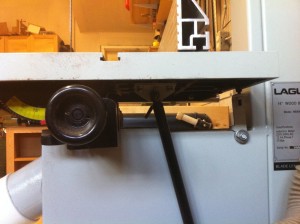
Facing the outfeed side of the saw, the tilt stop is on the right. It swings down to the right when it is not needed.
The table on this saw is generously sized and heavy. The trunnions are beefy and solid, and the tilt mechanism has a geared adjustment knob with a gas spring strut to assist. There are two locking knobs, which are comfortably sized. Adjusting the tilt is a two handed operation, as the table is heavy enough that it will fall fairly heavily back to its positive stop if you let go of the adjustment knob without the locking knobs tightened. The tilt control knob is smooth, a little bit small and a little slippery to grip, but it gets the job done.
The positive stop is effective and doesn’t have any play. When tilting the left side of the table down, the positive stop swings out of the way to allow the table to drop down. Swinging the positive stop back into position, the table reliably returns to square with the blade. The cursor on the tilt, like the cursor on the fence, suffers from parallax. Again, this being a band saw, I doubt anybody expects or requires 1/10th of a degree accuracy here so this is sufficient.
Dust Collection
I am generally happy with the dust collection on this saw. I never bothered to install the wooden baffle that the instruction manual recommends for the front dust port. The user guide indicates that the machine requires 1000 CFM, and I’m sure I’m nowhere near that. So even though I don’t meet the machine’s requirements and I haven’t really taken the time to set it up precisely as prescribed, it’s working alright. In use, a little bit of dust accumulates on the inside of the bottom door, and a little accumulates around the wiring for the micro switch on the foot brake, but in general, it doesn’t pile up. It doesn’t look like much dust makes it up to the upper cabinet.
The one improvement I could suggest for this machine would be to put the front dust port on the outfeed side of the machine. I have no idea why so many band saws have their dust ports on the front of the machine like this, as it pretty much guarantees 180 degree turn to reach the dust collection pipes. Fortunately, the pipes don’t stick out past the edge of the table the way I have them set up.
One happy surprise was that the ports on this machine fit snugly inside a standard 100mm PVC street elbow. On the bottom connection, I used a Hold Tite hose so that I could shape it to avoid contact with the motor. The rest of the dust collection fittings were cobbled together from scraps of hose and fittings I happened to have on hand.  There are two four inch dust ports on this saw, but if you look closely, the airflow on each is restricted to some degree. Feeding both ports from a single 4″ pipe seems to work alright, but I’m sure a 6″ pipe split to two 4″ pipes would work much better.
Mobility Kit
Laguna was running a promotion on this saw at the time of my purchase that included a lift-bar mobility kit for free. This mobility kit seems to be common to many European-designed machines, and it is absolutely not for me. I suppose it works, but in a tightly packed shop like mine, the main reason for needing mobility is to make room for the dozen other things that are getting moved around on a regular basis. I just plain don’t have space to swing a lift-bar around. I will probably replace the mobility kit with a more typical mobile base at some point, but for now, I haven’t had too many reasons to move it around, so it’s not doing me any harm. As a matter of personal preference, I would never have bought this mobility kit, at any price.
Summary
I like this saw, and I don’t think I’m going to outgrow it. This a heavy duty saw with great power and capacity, and it appears to be built to last. Maybe one day in a distant, probably imaginary future where space isn’t a concern for me, I’ll have an additional band saw dedicated to the little things like cutting curves and templates, but I’m pretty sure that this one will be standing not too far away set up for the heavier stuff that I tend to do most with my band saw.
Pros:
- Highest resaw capacity in its price range
- Largest left tilt range in its price range
- Footprint no bigger than most 14″ band saws
- Biggest motor in its price range
- Excellent blade tension mechanism
- Good build quality
- Dust collection works pretty well, even with under-spec dust collection
- Heavy castings
Cons:
- Difficult shipping grease removal
- No blade included
- No mitre gauge included
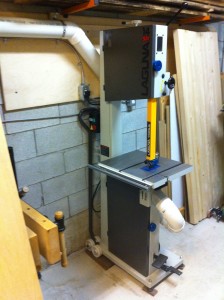
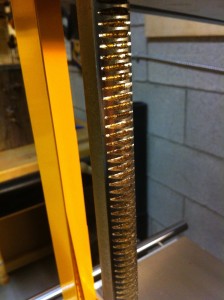
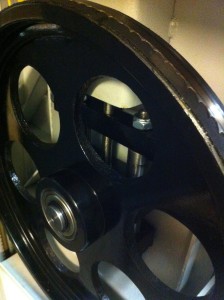
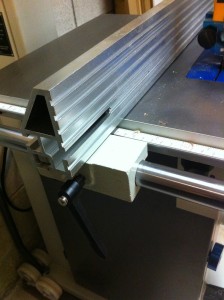
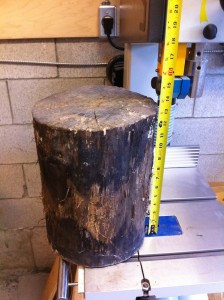
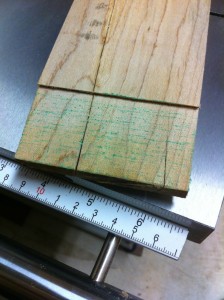
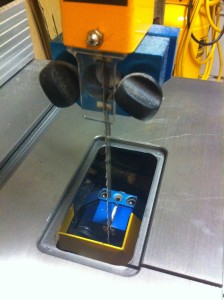
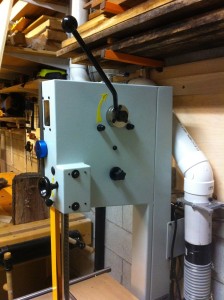
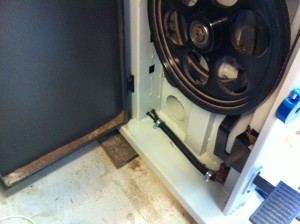
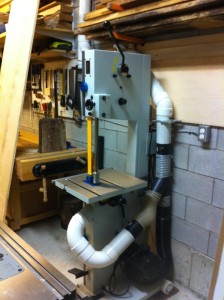
Comments: 4
Thanks for a great write-up. This was the most complete review of this BS that I’ve seen yet. Or for that matter any significant piece of machinery. Solidified my decision to get one after a long thinking process. Thanks again.
What is the overall height of the saw? I have limitations on how high the unit can be. Thank you.
There are two high points on this saw. I’m using the Laguna mobility kit with mine, so these measurements include the extra inch or so that it adds. Laguna officially lists the height of the machine as 70″.
The highest point is the knob on the tension quick release lever, which, when the tension is released, is about 74″ off the floor. The other high point is the tension adjustment crank, which is on top of the body of the saw. That is about 71 1/2″, but you would need a couple of inches of clearance above it to actually use it. If you don’t mind rolling it out from under whatever it is that is causing your height constraint, you can probably get away with about 72″. If it’s going to be stationary, you’ll probably want about 74″ to get your hand on top of it comfortably.
Great information. I also purchased a SUV 14 and have been very happy to date.
Interesting issue with the power cord. Not being an electrician, it took me a while to get the right circuit set up for the machine. As you noted, the plug on the machine is for a 20 amp circuit, yet Laguna recommends a 30amp circuit. When I called in to Laguna about that, there was actually a suggestion to cut the plug off. I ended up running a 20amp circuit on 12/3 and all is good.
The other issue I have had is sparks. I see you noted the issue in your blog. Again I spoke to Laguna about that and they weren’t sure why that was happening. Do we know what is causing that? Should I be concerned about it? I think the blade is set up properly from a tension perspective so I can’t really understand where the sparks are coming from.
As you mentioned, hardwood slides through effortlessly. I have been milling up some haliburton cherry that I have had sitting on the front porch for five years…..absolutely delightful!
Comments are closed.